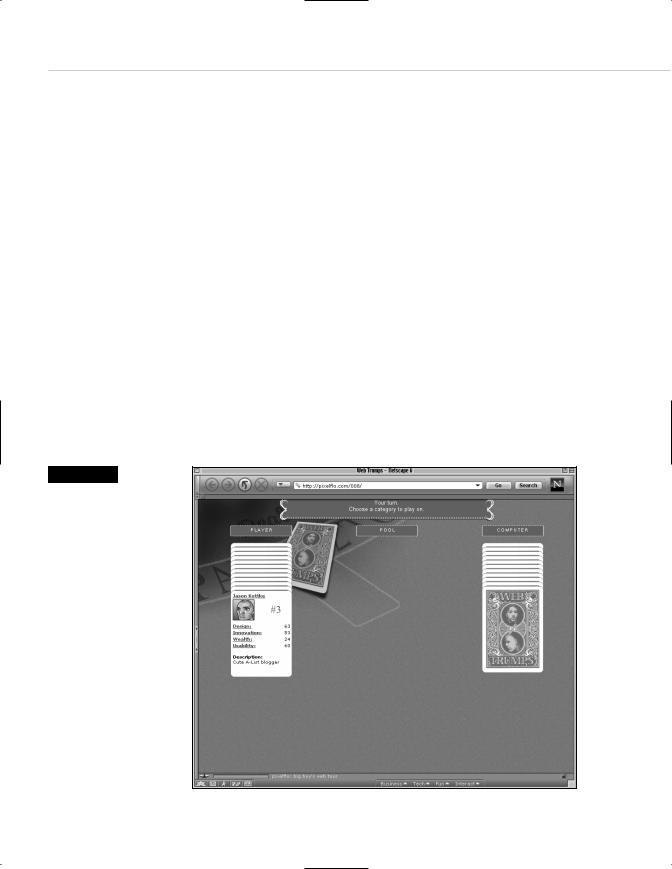
- •Taking Your Talent to the Web
- •Introduction
- •1 Splash Screen
- •Meet the Medium
- •Expanding Horizons
- •Working the Net…Without a Net
- •Smash Your Altars
- •Breath Mint? Or Candy Mint?
- •Where’s the Map?
- •Mars and Venus
- •Web Physics: Action and Interaction
- •Different Purposes, Different Methodologies
- •Web Agnosticism
- •Point #1: The Web Is Platform-Agnostic
- •Point #2: The Web Is Device-Independent
- •The 18-Month Pregnancy
- •Chocolatey Web Goodness
- •’Tis a Gift to Be Simple
- •Democracy, What a Concept
- •Instant Karma
- •The Whole World in Your Hands
- •Just Do It: The Web as Human Activity
- •The Viewer Rules
- •Multimedia: All Talking! All Dancing!
- •The Server Knows
- •It’s the Bandwidth, Stupid
- •Web Pages Have No Secrets
- •The Web Is for Everyone!
- •Swap text and code for images
- •Prune redundancy
- •Cache as Cache Can
- •Much Ado About 5K
- •Screening Room
- •Liquid Design
- •Color My Web
- •Thousands Weep
- •Gamma Gamma Hey!
- •Typography
- •The 97% Solution
- •Points of Distinction
- •Year 2000—Browsers to the Rescue
- •Touch Factor
- •Appropriate Graphic Design
- •User Knowledge
- •What Color Is Your Concept?
- •Business as (Cruel and) Usual
- •The Rise of the Interface Department
- •Form and Function
- •Copycats and Pseudo-Scientists
- •Chaos and Clarity
- •A Design Koan: Interfaces Are a Means too Often Mistaken for an End
- •Universal Body Copy and Other Fictions
- •Interface as Architecture
- •Ten (Okay, Three) Points of Light
- •Be Easily Learned
- •Remain Consistent
- •Continually Provide Feedback
- •GUI, GUI, Chewy, Chewy
- •It’s the Browser, Stupid
- •Clarity Begins at Home (Page)
- •I Think Icon, I Think Icon
- •Structural Labels: Folding the Director’s Chair
- •The Soul of Brevity
- •Hypertext or Hapless Text
- •Scrolling and Clicking Along
- •Stock Options (Providing Alternatives)
- •The So-Called Rule of Five
- •Highlights and Breadcrumbs
- •Consistent Placement
- •Brand That Sucker!
- •Why We Mentioned These Things
- •The year web standards broke, 1
- •The year web standards broke, 2
- •The year web standards broke, 3
- •The year the bubble burst
- •5 The Obligatory Glossary
- •Web Lingo
- •Extranet
- •HTML
- •Hypertext, hyperlinks, and links
- •Internet
- •Intranet
- •JavaScript, ECMAScript, CSS, XML, XHTML, DOM
- •Web page
- •Website
- •Additional terminology
- •Web developer/programmer
- •Project manager
- •Systems administrator (sysadmin) and network administrator (netadmin)
- •Web technician
- •Your Role in the Web
- •Look and feel
- •Business-to-business
- •Business-to-consumer
- •Solve Communication Problems
- •Brand identity
- •Restrictions of the Medium
- •Technology
- •Works with team members
- •Visually and emotionally engaging
- •Easy to navigate
- •Compatible with visitors’ needs
- •Accessible to a wide variety of web browsers and other devices
- •Can You Handle It?
- •What Is the Life Cycle?
- •Why Have a Method?
- •We Never Forget a Phase
- •Analysis (or “Talking to the Client”)
- •The early phase
- •Design
- •Brainstorm and problem solve
- •Translate needs into solutions
- •Sell ideas to the client
- •Identify color comps
- •Create color comps/proof of concept
- •Present color comps and proof of concept
- •Receive design approval
- •Development
- •Create all color comps
- •Communicate functionality
- •Work with templates
- •Design for easy maintenance
- •Testing
- •Deployment
- •The updating game
- •Create and provide documentation and style guides
- •Provide client training
- •Learn about your client’s methods
- •Work the Process
- •Code Wars
- •Table Talk
- •XHTML Marks the Spot
- •Minding Your <p>’s and q’s
- •Looking Ahead
- •Getting Started
- •View Source
- •A Netscape Bonus
- •The Mother of All View Source Tricks
- •Doin’ it in Netscape
- •Doin’ it in Internet Explorer
- •Absolutely Speaking, It’s All Relative
- •What Is Good Markup?
- •What Is Sensible Markup?
- •HTML as a Design Tool
- •The Frames of Hazard
- •Please Frame Safely
- •Framing Your Art
- •<META> <META> Hiney Ho!
- •Search Me
- •Take a (Re)Load Off
- •WYSIWYG, My Aunt Moira’s Left Foot
- •Code of Dishonor
- •WYS Is Not Necessarily WYG
- •Publish That Sucker!
- •HTMHell
- •9 Visual Tools
- •Photoshop Basics: An Overview
- •Comp Preparation
- •Dealing with Color Palettes
- •Exporting to Web-Friendly Formats
- •Gamma Compensation
- •Preparing Typography
- •Slicing and Dicing
- •Rollovers (Image Swapping)
- •GIF Animation
- •Create Seamless Background Patterns (Tiles)
- •Color My Web: Romancing the Cube
- •Dither Me This
- •Death of the Web-Safe Color Palette?
- •A Hex on Both Your Houses
- •Was Blind, but Now I See
- •From Theory to Practice
- •Format This: GIFs, JPEGs, and Such
- •Loves logos, typography, and long walks in the woods
- •GIFs in Photoshop
- •JPEG, the Other White Meat
- •Optimizing GIFs and JPEGs
- •Expanding on Compression
- •Make your JPEGS smaller
- •Combining sharp and blurry
- •Animated GIFs
- •Creating Animations in ImageReady
- •Typography
- •The ABCs of Web Type
- •Anti-Aliasing
- •Specifying Anti-Aliasing for Type
- •General tips
- •General Hints on Type
- •The Sans of Time
- •Space Patrol
- •Lest We Fail to Repeat Ourselves
- •Accessibility, Thy Name Is Text
- •Slicing and Dicing
- •Thinking Semantically
- •Tag Soup and Crackers
- •CSS to the Rescue…Sort of
- •Separation of Style from Content
- •CSS Advantages: Short Term
- •CSS Advantages: Long Term
- •Compatibility Problems: An Overview
- •Working with Style Sheets
- •Types of Style Sheets
- •External style sheets
- •Embedding a style sheet
- •Adding styles inline
- •Fear of Style Sheets: CSS and Layout
- •Fear of Style Sheets: CSS and Typography
- •Promise and performance
- •Font Size Challenges
- •Points of contention
- •Point of no return: browsers of the year 2000
- •Absolute size keywords
- •Relative keywords
- •Length units
- •Percentage units
- •Looking Forward
- •11 The Joy of JavaScript
- •What Is This Thing Called JavaScript?
- •The Web Before JavaScript
- •JavaScript, Yesterday and Today
- •Sounds Great, but I’m an Artist. Do I Really Have to Learn This Stuff?
- •Educating Rita About JavaScript
- •Don’t Panic!
- •JavaScript Basics for Web Designers
- •The Dreaded Text Rollover
- •The Event Handler Horizon
- •Status Quo
- •A Cautionary Note
- •Kids, Try This at Home
- •The Not-So-Fine Print
- •The Ever-Popular Image Rollover
- •A Rollover Script from Project Cool
- •Windows on the World
- •Get Your <HEAD> Together
- •Avoiding the Heartbreak of Linkitis
- •Browser Compensation
- •JavaScript to the Rescue!
- •Location, location, location
- •Watching the Detection
- •Going Global with JavaScript
- •Learning More
- •12 Beyond Text/Pictures
- •You Can Never Be Too Rich Media
- •Server-Side Stuff
- •Where were you in ‘82?
- •Indiana Jones and the template of doom
- •Serving the project
- •Doing More
- •Mini-Case Study: Waferbaby.com
- •Any Size Kid Can Play
- •Take a Walk on the Server Side
- •Are You Being Served?
- •Advantages of SSI
- •Disadvantages of SSI
- •Cookin’ with Java
- •Ghost in the Virtual Machine
- •Java Woes
- •Java Woes: The Politically Correct Version
- •Java Joys
- •Rich Media: Exploding the “Page”
- •Virtual Reality Modeling Language (VRML)
- •SVG and SMIL
- •SMIL (through your fear and sorrow)
- •Romancing the logo
- •Sounds dandy, but will it work?
- •Promises, Promises
- •Turn on, Tune in, Plug-in
- •A Hideous Breach of Reality
- •The ubiquity of plug-ins
- •The Impossible Lightness of Plug-ins
- •Plug-ins Most Likely to Succeed
- •Making It Work: Providing Options
- •The “Automagic Redirect”
- •The iron-plated sound console from Hell
- •The Trouble with Plug-ins
- •If Plug-ins Run Free
- •Parting Sermon
- •13 Never Can Say Goodbye
- •Separation Anxiety
- •A List Apart
- •Astounding Websites
- •The Babble List
- •Dreamless
- •Evolt
- •Redcricket
- •Webdesign-l
- •When All Else Fails
- •Design, Programming, Content
- •The Big Kahunas
- •Beauty and Inspiration
- •Index

Taking Your Talent to the Web |
271 |
value=”Previous Reports” onClick=”window.location=’com0400d.html’;” onMouseOver=”window.status=’More of same.’; return true;” onMouseOut=”window.status=’’;return true;”>
</form>
</div>
TROUBLE IN PARADISE: CSS COMPATIBILITY
ISSUES
The first web browser to attempt to support CSS was Microsoft Internet Explorer 3.0 (1997). It supported about 30% of the standard. A year later, Netscape 4 came out with support that was marginally better than that of IE3. During three years of hell, while Netscape sought to rebuild its browser from the ground up, Navigator 4 sat rotting on the market—its once-proud CSS support looking more and more shoddy. IE4 got more of it right and was soon replaced by IE5, which got still more of it right. No browser got it absolutely right, and baffled web users were often reluctant to upgrade to incremental (4.52 anybody?) versions of these browsers.
Thus support for CSS lagged, and problems abounded. In 1998, The Web Standards Project (www.webstandards.org) was formed to advocate and shore up support for CSS and other web standards, and A List Apart
(www.alistapart.com) began running the “Fear of Style Sheets” series.
Fear of Style Sheets: CSS and Layout
One of the great strengths of CSS is its ability to position elements on a web page. Elements may be positioned by exact pixel coordinates (400 pixels from the top, 32 pixels from the left, for example). They may be positioned relative to each other. They may be positioned via percentages, permitting web designers to easily set up liquid layouts, as previously discussed.
Unfortunately, CSS positioning is not supported in IE3 and is poorly supported in Netscape Navigator 4. In fact, it can cause the browser to crash, as detailed in A List Apart’s article, “The Day The Browser Died” (www.alistapart.com/stories/died/).

272 HOW: Style Sheets for Designers: Trouble in Paradise
Figure 10.4
Web Trumps, a card game featuring well-known web personalities, uses CSS to control the positioning and layering of every image on the page and JavaScript to reveal new layers during game play. Web Trumps is a minimasterpiece of graphic design and web program- ming—but one requiring the use of a modern browser. Experiments like this help hasten the day web designers can apply the same level of sophistication to commercial designs without worrying about browser incompatibilities (http:// pixelflo.com/008/).
So until IE3 and Netscape 4 leave the market, many of us will probably keep using HTML tables to create our web layouts. Web pages laid out with HTML tables will work in Netscape 1, 2, 3, 4, and 6; in IE 2, 3, 4, 5 and beyond; and in all other graphical browsers, including Opera and iCab.
If you’ve been following along, you’ll realize this means that web designers still cannot safely separate style from content on commercial projects and will continue to face difficulties in creating sites that work well outside the traditional desktop computer-based browser. But in the trenches, where work gets done, it also means that we can create sites that work for our clients and our clients’ audiences.
By late 2001 or soon after, we should be free to truly harness the power of CSS. Meanwhile, on personal, noncommercial projects, we can explore the full potential of CSS and other web standards without fear of hurting our clients’ customers (see Figure 10.4). It is hoped that these noncommercial usages of CSS and other web standards help widen interest in emerging technologies and encourage quicker adoption of newer, more standardscompliant browsers.

Taking Your Talent to the Web |
273 |
Fear of Style Sheets: Leading and Image
Overlap
As mentioned earlier in this chapter, CSS leading provides a standard means of improving the legibility and aesthetics of textual presentations on the Web—something every site designer should care about. And it does this while avoiding all the problems associated with transparent GIF hacks and other nonstandard visual workarounds.
The CSS line-height property solves all the old problems, but it can lead to new ones, particularly in older browsers whose support for CSS is largely theoretical. For instance, in the following example, if CSS line-height is specified for the <p> tag, the image will float on top of the text in both IE3 and early versions of Navigator 4:
<p><img src=”dog.gif” width=”100” height=”100” alt=”My dog, Pookie.” title=”Pookie is a friendly mutt.” align=”left”>My dog Pookie liked this text so much, he decided to sit on it in IE3 and Navigator 4.</p>
This problem is more prevalent in Mac OS than in Windows, largely because big browser companies spend more time and resources developing browsers for Windows than for other operating systems. (All the more miraculous then, that in the year 2000 the best browser on the market was IE5/Mac. Arguably it is still the best.) The solution to image overlap is to keep images outside of paragraphs and <div> tags. Unfortunately, doing so brings up yet another problem in Netscape Navigator 4:
<img src=”dog.gif” width=”100” height=”100” alt=”My dog, Pookie.” Title=”Pookie is a friendly mutt.” align=”left”>
<p>My dog Pookie liked this text so much, he decided to shove it to the right in its own little column in Navigator 4.</p>
With a left-aligned image placed outside the <p></p>, some versions of Netscape Navigator 4 will stick all the paragraph text in an imaginary column to the right of the image, as if the web designer had desired to create such a column. New paragraphs, in turn, will appear also in that unwanted column. Many a simple layout has been ruined in this way.
There is no solution to this problem. No matter which approach is used, some Netscape 4 users are going to get an ugly layout. Because an unwanted and mindlessly stupid column is preferable to text that is hid-
